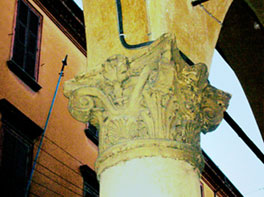|
BED AND BREAKFAST IN BOLOGNA ACCOMMODATION IN BOLOGNA ERBORISTERIA WEBMASTER |
||||||
|
|
In the 17th Century the strategic plan that began one
thousand years earlier was almost completed: Papal supremacy revealed
itself through ninety-six monastic complexes which made Bologna a city of
monasteries. The Church's strategic plan involving Bologna began in
the 6th Century AD., when the Benedictines established their monasteries
in four different places, at both ends of the "decumanum maximum" and
"cardo", outside the circle of the selenite walls. Afterwards other
monastic orders settled along the radial roads of this area, near the
"Torresotti" circle of walls (the Carmelites in St.
Martino Maggiore, the Augustines, in St. Giacomo Maggiore, the
Lateranenses in St. Giovanni in Monte, the Dominicans in St. Domenico, the
Franciscans in St. Francesco, the regular canons in St. Salvatore).
So a particular urban structure took shape: the monastic complex -
consisting of the church, the bell-tower, the largest part of the building
where the monks lived, with cloisters and porticoes, rooms and cells,
chapels, refectories and cellars - was in the centre of a group of little
streets where "the poor" built their "portichetti", that is to say the
"houses in a row"; two rows of houses facing into two parallel streets,
with space in the middle for the vegetable gardens. The counter-Reformation found in Bologna its greatest
centre for didatic image production. ln the Palazzo Davia Bargellini, No. 44, Strada Maggiore
there is the Museum of Industrial Art and the Davia
Bargellini Gallery which houses paintings of great
value together with documents of the bourgeoise and the noble house from
the Renaissance but mainly from the Baroque period. Another important
group of paintings it to be found at the Municipal Art Collections in the
Municipal Palace. |
|
b u |
|||
|
General - Environment - Iron and Etruscan Age - Roman Age - Patron Saint- The Commune - Alma mater studiorum - Re Enzo - Porticoes - St Peter - Gothic - 14th Century - Piazza Maggiore - Aristocratic palaces - Brick and other stones - Early 15th Century - Archiginnasio - Counter Reformation Renaissance - 16th Century - Great portico ribbons - Frescoes in palaces - The "scenographic" city - Napoleon's republics - Fall of Church power - The Restoration - Haussmann style - The new Century - Floreal style - Rationalism - World War - Active preservation - Around 2000 |
||||||
